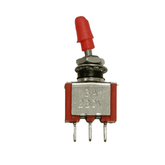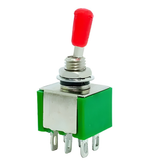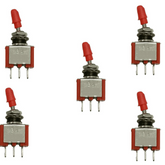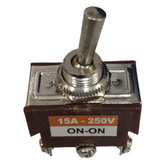The Complete Guide to Toggle Switches
Summary
Dive into the world of toggle switches with our comprehensive guide! From understanding the mechanics behind these versatile devices to exploring their various types and specialized variants, we cover it all. Learn about the critical role of electrical contacts and how springs contribute to toggle switch functionality. Discover real-world applications and gain valuable insights into troubleshooting common issues. Whether you're a beginner or a seasoned pro, this guide will help you choose the right toggle switch for your needs. Don't miss out on unlocking the power of toggle switches – read on for a complete journey into their world!
Introduction
Toggle switches are the unsung heroes of the electrical world. These humble yet powerful components offer a simple way to control the flow of electricity with a flick of a lever or twist of a knob.
From household appliances to industrial machinery, toggle switches play a crucial role in managing electrical circuits, allowing us to turn things on and off effortlessly.
Let's begin on a comprehensive journey into the fascinating world of toggle switches, exploring their mechanics, types, applications, selection criteria, and troubleshooting techniques.
Understanding Toggle Switches
A Primer Before looking into the complexities of toggle switches, let's establish a foundational understanding of what they are and how they work.
What is a Toggle Switch?
Hey there! Ever wondered how we control the flow of electricity in different gadgets and devices?
Well, let me introduce you to a nifty little tool called a toggle switch. You know those light switches at home that you push up to turn on and push down to turn off?

A toggle switch works a bit like that, but instead of pushing, you flip a little lever or knob up and down, like playing with a mini seesaw! Think of it as a gatekeeper for electricity.
When you flip the lever up, it's like opening a gate to let electricity flow through. Flip it down, and it's like closing the gate to stop the electricity. Pretty neat, huh?
You can spot toggle switches in all sorts of places, from your favorite toys to electronic gadgets like radios.
They're super handy because with just a flick of that little lever, you can turn things on and off in a snap!
How Does a Toggle Switch Work?
Let's take a peek inside the magical world of toggle switches to see how they do their thing! Inside, there are these tiny parts that fit together like puzzle pieces.
When you move the lever or knob, these puzzle pieces either connect to let electricity flow (when it's "on") or disconnect to stop the electricity (when it's "off").
Picture it like this: when you flip the lever up, it's like solving a puzzle and connecting all the pieces, completing the circuit and letting electricity pass through.

But when you flip the lever down, it's like taking those puzzle pieces apart, breaking the circuit and stopping the electricity flow.
So, it's all about these little puzzle pieces inside the switch, deciding whether we want the electricity to flow or not. It's like a game of electrical puzzles, and with each flip of the lever, we control the power! Cool, right?
Mechanics of Toggle Switches
Toggle switches operate on the basic principle of a seesaw mechanism. The lever or knob serves as the fulcrum, with one end connected to the movable contact and the other end linked to the stationary contact.

Flipping the lever causes the contacts to move accordingly, establishing or disrupting electrical continuity.
Electrical Contacts
At the core of every toggle switch are the electrical contacts, which play a pivotal role in controlling the flow of electricity. These contacts consist of two parts: a stationary contact that remains fixed in place and a movable contact that can be toggled between positions.
When the switch is turned on, the movable contact makes contact with the stationary one, allowing electricity to pass through. Conversely, when the switch is turned off, the contacts separate, interrupting the flow of current.
The Role of Springs in Toggle Switches
Springs are integral components of toggle switches, providing the necessary tension to ensure reliable contact between the movable and stationary contacts.
When the switch is flipped on, the spring mechanism helps to firmly press the contacts together, ensuring a stable electrical connection.
Additionally, springs facilitate the smooth operation of the switch by assisting the movable contact in returning to its original position when the switch is turned off. This prevents arcing and ensures a clean break in the circuit.
Exploring the Types of Toggle Switches
Toggle switches come in various configurations, each designed to suit specific applications and requirements. Let's take a closer look at the most common types:
Single-Pole Single-Throw (SPST)
SPST toggle switches are the simplest and most common type of toggle switch. They feature a single input (pole) and a single output (throw), allowing for straightforward on/off control of a circuit.

SPST switches are akin to binary switches, offering a clear choice between two states—on or off.
Single-Pole Double-Throw (SPDT)
SPDT toggle switches offer more versatility than their SPST counterparts. With one input (pole) and two outputs (throws), SPDT switches enable users to select between two different circuit paths.

This makes them ideal for applications where multiple connections or switching options are required.
Double-Pole Single-Throw (DPST)
DPST toggle switches feature two separate input (pole) and output (throw) circuits, allowing for simultaneous control of two independent circuits with a single switch.

They offer double the capacity of SPST switches, making them suitable for applications that require managing multiple electrical loads.
Double-Pole Double-Throw (DPDT)
DPDT toggle switches are the most versatile type of toggle switch, offering two inputs (poles) and four outputs (throws).

With the ability to control two separate circuits and choose between two options for each circuit, DPDT switches are well-suited for complex switching applications where flexibility is paramount.
Specialized Variants
In addition to the basic types, there are specialized variants of toggle switches designed for specific tasks:
- Center-Off Toggle Switches: These switches feature a neutral center position in addition to the standard on/off positions. They are often used in applications where a momentary pause or neutral state is required between on and off positions.
- Momentary Toggle Switches: Unlike traditional toggle switches that latch in the on or off position, momentary toggle switches return to their default position when released. They are commonly used in applications where a temporary or momentary action is needed, such as in doorbell circuits or alarm systems.
- Illuminated Toggle Switches: These switches feature built-in indicator lights that illuminate when the switch is in the on position, providing visual feedback to the user. Illuminated toggle switches are often used in low-light environments or applications where status indication is important.
- Sealed Toggle Switches: Sealed toggle switches are designed to withstand harsh environmental conditions, such as moisture, dust, and extreme temperatures. They are commonly used in outdoor or industrial applications where exposure to the elements is a concern.
Applications
Toggle switches find applications across a wide range of industries and sectors, thanks to their versatility, reliability, and ease of use. Here are some common applications:
- Industrial Controls: In industrial settings, toggle switches are used to control a variety of equipment and machinery, including motors, lights, and conveyors. Their rugged construction and dependable performance make them well-suited for the demanding conditions found in factories and manufacturing plants.
- Automotive: Toggle switches are commonly found in automotive applications, where they are used to control various functions such as lights, wipers, and accessories. Their simple design and intuitive operation make them ideal for use in vehicles, where reliability is essential.
- Aerospace: In the aerospace industry, toggle switches play a crucial role in controlling critical systems onboard aircraft, including lighting, avionics, and landing gear. Their robust construction and ability to withstand high temperatures and vibrations make them ideal for use in the challenging environment of aviation.
- Consumer Electronics: In the field of consumer electronics, toggle switches are used to control a wide range of devices and appliances, from lamps and radios to kitchen appliances and power tools. Their compact size, ease of installation, and affordability make them a popular choice for manufacturers and DIY enthusiasts alike.
Choosing the Right Toggle Switch
Selecting the right toggle switch for your application requires careful consideration of several factors:
- Current and Voltage Ratings: Ensure that the toggle switch is rated to handle the electrical load of your application. Pay attention to both the current and voltage ratings, as exceeding these limits can lead to overheating, damage, or failure of the switch.
- Environmental Conditions: Consider the environmental conditions in which the toggle switch will be used, such as temperature extremes, moisture, and exposure to chemicals. Choose a switch with appropriate environmental protection ratings, such as IP ratings, to ensure reliable performance in these conditions.
- Size and Mounting: Select a toggle switch that fits within the available space and is compatible with the mounting requirements of your application. Consider factors such as the size, shape, and mounting hardware of the switch to ensure a secure and reliable installation.
- Durability and Reliability: Choose a toggle switch that is built to last, with durable materials and construction that can withstand frequent use and harsh conditions. Look for switches with a proven track record of reliability and longevity in similar applications.
- Ergonomics and User Experience: Consider the ergonomics of the toggle switch, including the design of the lever or knob and the feel of the switch when operated. Choose a switch that is comfortable to use and provides clear feedback to the user, such as a satisfying click or tactile sensation.
Troubleshooting Common Issues
Even the most reliable toggle switches can experience issues over time. Here are some common problems and their potential solutions:
Unresponsive Switch
If the switch fails to operate when toggled, it may be due to dirt, debris, or corrosion affecting the internal mechanism.
Clean the switch thoroughly with compressed air or a soft brush to remove any foreign particles, and apply a small amount of contact cleaner if necessary.
Loose Components
Over time, the internal components of a toggle switch may become loose, causing instability or poor contact.
Tighten any mounting screws or connections to ensure a secure fit and reliable operation.
Audible Noise
A noisy toggle switch may be caused by worn or misaligned internal components.
Apply a small amount of lubricating oil to the moving parts of the switch to reduce friction and noise, and check for any signs of wear or damage that may require repair or replacement.
Physical Damage
Physical damage to the toggle switch, such as broken or bent components, can impair its operation.
If the switch is damaged beyond repair, replace it with a new one from a reputable manufacturer to ensure continued reliability and performance.
Faulty Wiring or Connections
Sometimes, the issue may not lie with the toggle switch itself, but with the wiring or connections in the circuit.
Check for loose or damaged wires, corroded connections, or faulty components, and repair or replace them as necessary to restore proper functionality.
By addressing these common issues and following the recommended solutions, you can ensure that your toggle switches continue to provide reliable performance for years to come.
Conclusion
Toggle switches may seem like simple devices, but their impact on modern technology and everyday life is profound.
From controlling lights and appliances in our homes to managing critical systems in industrial and aerospace settings, these unassuming components play a vital role in electrical control and automation.
By understanding the mechanics, types, applications, selection criteria, and troubleshooting techniques of toggle switches, you'll be better equipped to harness their power and unlock a world of possibilities.
Whether you're a hobbyist, a DIY enthusiast, or a professional engineer, toggle switches offer a versatile and reliable solution for controlling electrical circuits with precision and ease.
So the next time you flip a switch to turn on a light or activate a piece of equipment, take a moment to appreciate the humble toggle switch—and the remarkable technology that makes it all possible.










